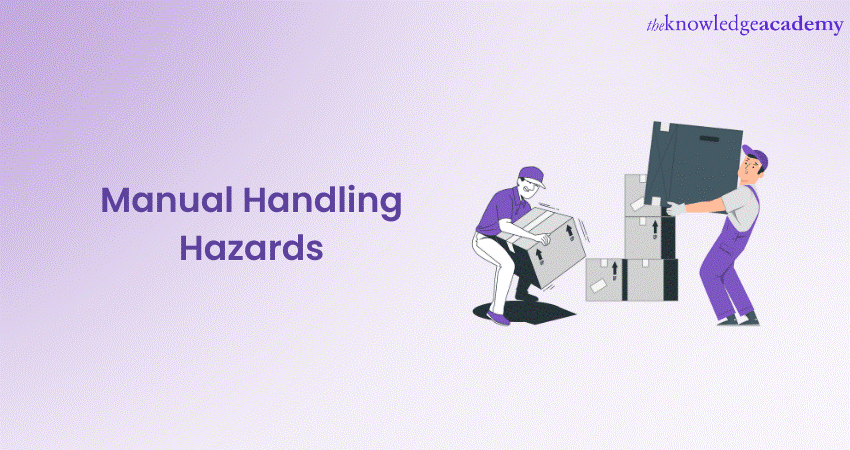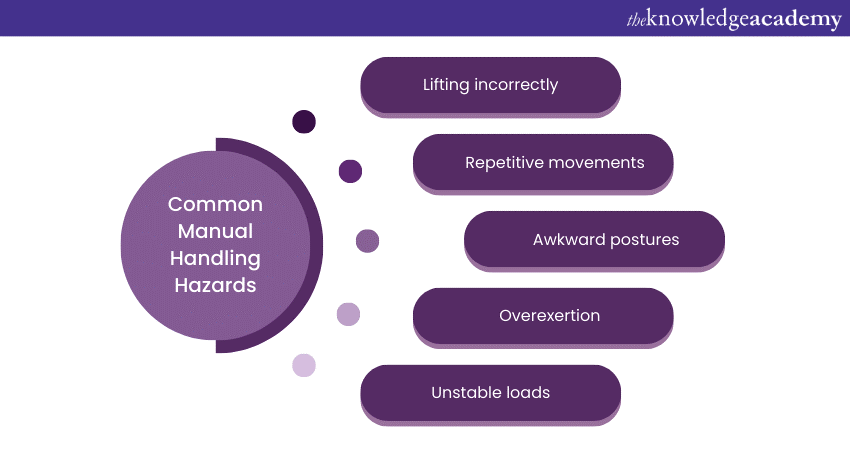We may not have the course you’re looking for. If you enquire or give us a call on +1 6474932992 and speak to our training experts, we may still be able to help with your training requirements.
Training Outcomes Within Your Budget!
We ensure quality, budget-alignment, and timely delivery by our expert instructors.

Manual Handling, a fundamental aspect of various industries, involves physically moving or adjusting objects, encompassing tasks such as lifting and carrying. While integral to daily operations, Manual Handling activities also pose significant hazards that demand our attention. In this blog, we will learn about various Manual Handling Hazards and get informed on how to avoid such hazards at the workplace.
Table of Contents
1) Understanding Manual Handling
2) Common Manual Handling Hazards
3) Consequences of Manual Handling Hazards
4) Preventing Manual Handling Hazards
5) Conclusion
Understanding Manual Handling
Manual Handling is a cornerstone of diverse industries, encompassing a spectrum of tasks that involve lifting, carrying, pushing, pulling, or adjusting objects by hand. This physical interaction between individuals and objects is ubiquitous in workplaces, ranging from construction sites and warehouses to healthcare facilities and offices. To comprehensively grasp the significance of Manual Handling, consider the following points: s:
a) Varied applications: Manual Handling tasks can occur in numerous forms, from lifting heavy construction materials to transporting medical equipment in healthcare settings. Each task demands a nuanced approach to minimise risks.
b) Inherent complexity: Manual Handling might appear simple, but its complexity lies in the dynamic interplay between human biomechanics and external forces. Factors like an object's weight, shape, grip, and posture contribute to the risk level.
c) Task frequency: Manual Handling activities are often performed repetitively throughout the workday. This frequency amplifies the potential for strain on muscles, tendons, and joints, gradually increasing the risk of injuries.
d) Multifaceted challenges: Beyond physical exertion, Manual Handling tasks can involve cognitive and environmental challenges. Navigating confined spaces, uneven surfaces, or time-sensitive demands adds complexity to the process.
e) Adapting to context: Different industries require distinct Manual Handling approaches. For instance, healthcare workers may handle patients with varying mobility levels, necessitating adaptable Manual Handling Techniques to ensure patient and staff safety.
f) Employee empowerment: Providing employees with a comprehensive understanding of Manual Handling tasks equips them to make informed decisions while working. Recognising the potential risks and understanding how to mitigate them empowers individuals to protect their well-being.
g) Importance of ergonomics: Ergonomics plays a pivotal role in Manual Handling. Designing workspaces, tools, and equipment that align with the human body's natural movements can significantly reduce the strain associated with manual tasks.
h) Training and skill development: Proper training is essential to ensure that employees are equipped with the skills to execute Manual Handling tasks safely and efficiently. This involves teaching techniques for lifting, carrying, and manoeuvring objects while maintaining optimal posture.
i) Collaborative efforts: Understanding Manual Handling Hazards is not the sole responsibility of workers; it involves collaboration between employees, supervisors, and employers. An integrated approach encourages open Effecctive Communication about potential hazards and solutions.
j) Continuous improvement: The landscape of Manual Handling is ever evolving. Regular assessments, feedback loops, and learning from incidents enable organisations to refine their approaches, ultimately fostering a culture of safety and well-being.
Gain knowledge on Manual Handling and safe lifting; sign up for our Manual Handling At Work Training now!
Common Manual Handling Hazards
While seemingly routine, Manual Handling tasks can harbour various hazards that pose significant risks to workers' well-being. Identifying and comprehending these hazards is crucial for fostering a safer working environment. Let's look at some of the most common Manual Handling Hazards and their implications:

Lifting incorrectly:
a) Incorrect lifting techniques, such as bending at the waist or twisting while lifting, can lead to strained muscles, particularly in the back.
b) Over time, such practices can cause acute injuries like sprains and strains, as well as chronic conditions like herniated discs.
Repetitive movements:
a) Repeating the same Manual Handling motion frequently, without adequate breaks, can result in cumulative trauma to muscles, tendons, and nerves.
b) Conditions like Repetitive Strain Injuries (RSIs) or carpal tunnel syndrome can emerge from these repetitive movements, causing discomfort and reduced productivity.
Awkward postures:
a) Assuming unnatural or awkward postures during Manual Handling increases the musculoskeletal injury risk.
b) Prolonged working periods in strained positions can lead to long-term health issues, including chronic pain and decreased range of motion.
Overexertion:
a) Exerting excessive force to move heavy objects can cause physical strain on the muscles and cardiovascular system.
b) Overexertion can lead to sudden injuries, like muscle pulls or even heart strain, especially if the worker is not conditioned for such exertion.
Unstable loads:
a) Carrying unevenly distributed or inherently unstable loads can lead to loss of balance and falls.
b) Such incidents can result in fractures, sprains, or more severe injuries if the load falls on the worker.
Insufficient rest and recovery:
a) Failing to allow adequate time for rest and recovery between Manual Handling tasks can exacerbate fatigue and increase the risk of injuries.
b) Fatigue impairs muscle coordination, reaction times, and overall judgment, contributing to higher accident rates.
Inadequate training:
a) Lack of proper training in Manual Handling techniques increases the likelihood of workers using unsafe methods, leading to injuries.
b) Proper training educates employees about the risks associated with Manual Handling and equips them with risk mitigation strategies.
Ignoring ergonomics:
a) Workspaces and equipment that do not account for ergonomic principles can force workers into uncomfortable positions, amplifying the risk of injuries.
b) Ergonomic design minimises strain on the body and promotes natural movements during Manual Handling tasks.
Time pressure:
a) Being pressed for time while performing Manual Handling tasks can lead to rushed and unsafe practices.
b) Workers may bypass proper techniques to complete tasks quickly, increasing the likelihood of accidents.
Psychosocial factors:
a) Factors such as stress, lack of job satisfaction, and poor work-life balance can indirectly impact Manual Handling safety by affecting concentration and focus.
Establish a proactive health and safety work culture; sign up for our Health & Safety in the Workplace Training now!
Consequences of Manual Handling Hazards
Neglecting the potential consequences of Manual Handling Hazards can have far-reaching impacts on both individuals and workplaces. From immediate injuries to long-term health issues, understanding these outcomes is essential for fostering a safety culture. Let's explore the significant consequences that can arise from hazardous Manual Handling.
Musculoskeletal injuries:
a) Strained muscles, ligaments, and tendons resulting from improper lifting or repetitive movements can lead to acute injuries like sprains, strains, and muscle tears.
b) In severe cases, these injuries can cause debilitating pain, restricted mobility, and even the need for surgical intervention.
Workplace accidents:
a) Poor Manual Handling practices can increase the risk of accidents like slips, trips, and falls, often resulting in fractures, dislocations, and head injuries.
b) Accidents lead to physical injuries and impact workplace productivity and morale.
Long-term health issues:
a) Untreated or improperly managed Manual Handling injuries can contribute to chronic health conditions like chronic back pain, arthritis, and nerve disorders.
b) These long-term health issues can significantly reduce the affected individual's quality of life and lead to extended periods of absence from work.
Reduced productivity:
a) Employees suffering from Manual Handling injuries may experience decreased productivity due to limited physical capabilities.
b) Lower productivity not only affects individual performance but also impacts team efficiency and overall company output.
Financial costs:
a) Workplace injuries resulting from Manual Handling Hazards can lead to substantial financial costs for employers and Employees.
b) Medical expenses, rehabilitation, and potential legal fees can create a significant financial burden.
Absence and turnover:
a) Employees with Manual Handling injuries may require time off for recovery, leading to temporary workforce shortages.
b) In extreme cases, the physical strain and discomfort caused by Manual Handling Hazards can contribute to employee dissatisfaction and turnover.
Mental well-being:
a) Manual Handling injuries can cause chronic pain that can negatively impact an individual's Mental Health, resulting in stress, anxiety, and depression.
b) Workplace injuries can also contribute to frustration and helplessness, affecting overall job satisfaction.
Legal consequences:
a) If Manual Handling Hazards are ignored and a safe work environment is not provided, it can lead to legal consequences.
b) Non-compliance with occupational health and safety regulations may lead to fines, penalties, and damage to a company's reputation.
Interpersonal relationships: Injuries from Manual Handling can affect personal relationships because individuals may no longer be able to participate in activities they once enjoyed outside of work.
Cultural impact: If a workplace becomes known for neglecting safety and disregarding Manual Handling Hazards, it can lead to a negative organisational culture and a lack of employee trust.
Learn how to analyse and evaluate the risks sign up for our Health And Safety In The Workplace Training now!
Preventing Manual Handling Hazards
Proactive measures are paramount to ensure a safe working environment, mitigate risks, and promote the well-being of employees. By implementing strategies to prevent Manual Handling Hazards, workplaces can foster a safety culture and reduce the incidence of injuries. Consider the following points on effective preventive measures:
Training and education:
a) Comprehensive training programs educate employees about the risks associated with Manual Handling tasks and equip them with proper techniques.
b) Regular refresher courses reinforce safe practices and keep employees up to date with the latest guidelines.
Proper lifting techniques: Teaching employees how to lift objects correctly—bending at the knees, using leg muscles, and keeping the back straight—reduces strain on the spine and minimises the risk of injury.
Ergonomic design: Workspaces and equipment should be ergonomic, minimising the need for awkward postures and ensuring a more comfortable working environment.
Using assistive equipment: Implementing tools like carts, dollies, and lifting aids can significantly reduce the physical strain associated with Manual Handling tasks.
Risk assessment: Regularly assessing the risks associated with Manual Handling tasks helps identify potential hazards and allows for tailored solutions.
Employee involvement: Encouraging employees to report hazards and provide input on safety measures fosters a collaborative approach to preventing Manual Handling injuries.
Supervisor support: Supervisors play a crucial role in enforcing safe practices and guiding employees to ensure they follow proper techniques.
Regular breaks: Providing adequate rest breaks between Manual Handling tasks allows muscles to recover and minimises the risk of fatigue-related injuries.
Flexibility in workload: Allowing for rotation of tasks and workload adjustments can prevent overexertion and reduce the impact of repetitive movements.
Continuous improvement: Regularly reviewing and updating safety protocols based on incident analysis and feedback fosters a culture of continuous improvement in Manual Handling practices.

Conclusion
When it comes to Manual Handling Hazards, it is crucial to be aware and take action. By knowing the potential risks and implementing preventive measures, workplaces can become safe havens. When everyone is committed to protecting employees, it leads to improved well-being, higher productivity, and a positive organisational culture.
Frequently Asked Questions
Upcoming Health & Safety Resources Batches & Dates
Date
 Manual Handling at Work
Manual Handling at Work
Fri 10th Jan 2025
Fri 14th Feb 2025
Fri 11th Apr 2025
Fri 23rd May 2025
Fri 8th Aug 2025
Fri 26th Sep 2025
Fri 21st Nov 2025







 Top Rated Course
Top Rated Course


 If you wish to make any changes to your course, please
If you wish to make any changes to your course, please


